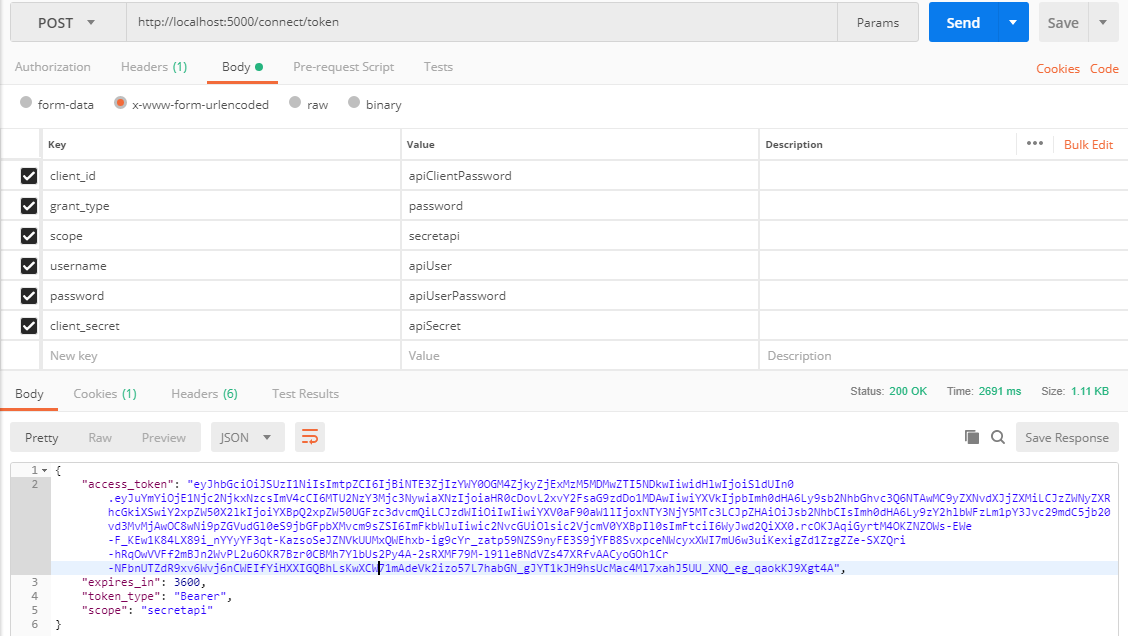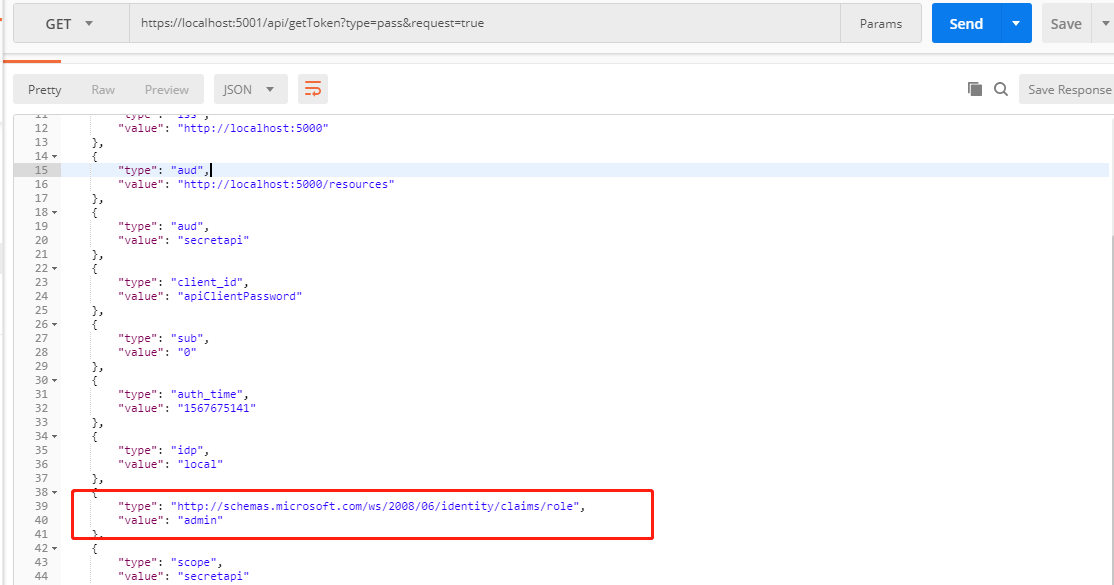接上一篇:IdentityServer4 初識,上一篇介紹了客戶端模式保護API訪問。這一篇講IdentityServer4 使用用戶名和密碼模式保護API訪問。 添加用戶:要用到用戶名稱密碼當然得添加用戶,在IdentityServer項目的Config類中的新增一個方法,GetUsers。返回一 ...
接上一篇:IdentityServer4 初識,上一篇介紹了客戶端模式保護API訪問。這一篇講IdentityServer4 使用用戶名和密碼模式保護API訪問。
- 添加用戶:要用到用戶名稱密碼當然得添加用戶,在IdentityServer項目的Config類中的新增一個方法,GetUsers。返回一個TestUser的集合。
public static List<TestUser> GetUsers() {
return new List<TestUser>()
{
new TestUser()
{
//用戶名
Username="apiUser",
//密碼
Password="apiUserPassword",
//用戶Id
SubjectId="0"
}
};
}
添加好用戶還需要要將用戶註冊到IdentityServer4,修改IdentityServer項目的Startup類ConfigureServices方法
public void ConfigureServices(IServiceCollection services)
{
services.AddMvc();
//添加IdentityServer
var builder = services.AddIdentityServer()
//身份信息授權資源
.AddInMemoryIdentityResources(Config.GetIdentityResources())
//API訪問授權資源
.AddInMemoryApiResources(Config.GetApis())
//客戶端
.AddInMemoryClients(Config.GetClients())
//添加用戶
.AddTestUsers(Config.GetUsers());
if (Environment.IsDevelopment())
{
builder.AddDeveloperSigningCredential();
}
else
{
throw new Exception("need to configure key material");
}
}
- 添加一個客戶端,用於用戶名和密碼模式的訪問。客戶端(Client)定義里有一個AllowedGrantTypes的屬性,這個屬性決定了Client可以被那種模式被訪問,GrantTypes.ClientCredentials為客戶端憑證模式,GrantTypes.ResourceOwnerPassword為用戶名密碼模式。上一節添加的Client是客戶端憑證模式,所以還需要添加一個Client用於支持用戶名密碼模式。
public static IEnumerable<Client> GetClients()
{
return new Client[] {
new Client()
{
//客戶端Id
ClientId="apiClientCd",
//客戶端密碼
ClientSecrets={new Secret("apiSecret".Sha256()) },
//客戶端授權類型,ClientCredentials:客戶端憑證方式
AllowedGrantTypes=GrantTypes.ClientCredentials,
//允許訪問的資源
AllowedScopes={
"secretapi"
}
},
new Client()
{
//客戶端Id
ClientId="apiClientPassword",
//客戶端密碼
ClientSecrets={new Secret("apiSecret".Sha256()) },
//客戶端授權類型,ClientCredentials:客戶端憑證方式
AllowedGrantTypes=GrantTypes.ResourceOwnerPassword,
//允許訪問的資源
AllowedScopes={
"secretapi"
}
}
};
}
至此,服務端工作完成。轉到IentityApi項目。
- 在後臺獲取Token:IdentityModel為支持用戶名密碼模式,對HttpClient做了一個擴展方法:RequestPasswordTokenAsync,修改一下IdentityController控制器的getToken介面,讓它支持用戶名密碼模式獲取Token
[HttpGet]
[Route("api/getToken")]
public async Task<object> GetCdTokenAsync(string type,bool? request)
{
var client = new HttpClient();
var disco = await client.GetDiscoveryDocumentAsync("http://localhost:5000");
TokenResponse resp = null;
switch (type)
{
case "cd":
resp = await client.RequestClientCredentialsTokenAsync(new ClientCredentialsTokenRequest
{
//獲取Token的地址
Address = disco.TokenEndpoint,
//客戶端Id
ClientId = "apiClientCd",
//客戶端密碼
ClientSecret = "apiSecret",
//要訪問的api資源
Scope = "secretapi"
});
break;
case "pass":
resp = await client.RequestPasswordTokenAsync(new PasswordTokenRequest()
{
//獲取Token的地址
Address = disco.TokenEndpoint,
//客戶端Id
ClientId = "apiClientPassword",
//客戶端密碼
ClientSecret = "apiSecret",
//要訪問的api資源
Scope = "secretapi",
//用戶名
UserName = "apiUser",
//密碼
Password = "apiUserPassword"
});
break;
}
//如果request為true,直接利用token訪問被保護的api
if (request??false&&null!=resp)
{
//添加Bearer認證頭
client.SetBearerToken(resp.AccessToken);
var reslut =await client.GetStringAsync("https://localhost:5001/api/identity");
JArray json = JArray.Parse(reslut);
return json;
}
return resp?.Json;
}
- 同樣,也可以通過HTTP請求獲取

獲取到Token後,訪問受保護的API和通過客戶端模式一樣。

到目前為止,昨們還沒有搞清這兩個模式有什麼區別,如果僅僅是為了能訪問這個API,那加不加用戶名和密碼有什麼區別呢。昨們對比下這兩種模式取得Token後訪問api返回的數據,可以發現用戶名密碼模式返回的Claim的數量要多一些。Claim是什麼呢,簡爾言之,是請求方附帶在Token中的一些信息。但客戶端模式不涉及到用戶信息,所以返回的Claim數量會少一些。在IdentityServer4中,TestUser有一個Claims屬性,允許自已添加Claim,有一個ClaimTypes枚舉列出了可以直接添加的Claim。添加一個ClaimTypes.Role試試。
IdentityServer.Config.GetUsers
public static List<TestUser> GetUsers() {
return new List<TestUser>()
{
new TestUser()
{
//用戶名
Username="apiUser",
//密碼
Password="apiUserPassword",
//用戶Id
SubjectId="0",
Claims=new List<Claim>(){
new Claim(ClaimTypes.Role,"admin")
}
}
};
}
這時如果啟動兩個項目,採用用戶密碼和密碼模式獲取Token訪問Api,返回的值依然是沒有role:admin的Claim的。這時又要用到ApiResouce,ApiResouce的構造函數有一個重載支持傳進一個Claim集合,用於允許該Api資源可以攜帶那些Claim。
IdentityServer.Config.GetApis
public static IEnumerable<ApiResource> GetApis()
{
return new ApiResource[] {
//secretapi:標識名稱,Secret Api:顯示名稱,可以自定義
new ApiResource("secretapi","Secret Api",new List<string>(){ ClaimTypes.Role})
};
}
現在可以啟動IdentityApi和IdentityServer兩個項目測試一下,可以發現已經可以返回role這個claim了。

Role(角色)這個Claim很有用,可以用來做簡單的許可權管理。
首先修改下被保護Api的,使其支持Role驗證
IdentityApi.Controllers.IdentityController.GetUserClaims
[HttpGet]
[Route("api/identity")]
[Microsoft.AspNetCore.Authorization.Authorize(Roles ="admin")]
public object GetUserClaims()
{
return User.Claims.Select(r => new { r.Type, r.Value });
}
然後在IdentityServer端添加一個來賓角色用戶
IdentityServer.Config.GetUsers
public static List<TestUser> GetUsers() {
return new List<TestUser>()
{
new TestUser()
{
//用戶名
Username="apiUser",
//密碼
Password="apiUserPassword",
//用戶Id
SubjectId="0",
Claims=new List<Claim>(){
new Claim(ClaimTypes.Role,"admin")
}
},
new TestUser()
{
//用戶名
Username="apiUserGuest",
//密碼
Password="apiUserPassword",
//用戶Id
SubjectId="1",
Claims=new List<Claim>(){
new Claim(ClaimTypes.Role,"guest")
}
}
};
}
再回到IdentityApi,修改下測試介面,把用戶名和密碼參數化,方便調試
IdentityApi.Controllers.IdentityController.getCdTokenAsync
[HttpGet]
[Route("api/getToken")]
public async Task<object> GetCdTokenAsync(string type,bool? request,string username,string password)
{
var client = new HttpClient();
var disco = await client.GetDiscoveryDocumentAsync("http://localhost:5000");
TokenResponse resp = null;
switch (type)
{
case "cd":
resp = await client.RequestClientCredentialsTokenAsync(new ClientCredentialsTokenRequest
{
//獲取Token的地址
Address = disco.TokenEndpoint,
//客戶端Id
ClientId = "apiClientCd",
//客戶端密碼
ClientSecret = "apiSecret",
//要訪問的api資源
Scope = "secretapi"
});
break;
case "pass":
resp = await client.RequestPasswordTokenAsync(new PasswordTokenRequest()
{
//獲取Token的地址
Address = disco.TokenEndpoint,
//客戶端Id
ClientId = "apiClientPassword",
//客戶端密碼
ClientSecret = "apiSecret",
//要訪問的api資源
Scope = "secretapi",
//用戶名
UserName = username,
//密碼
Password = password
});
break;
}
if (request??false&&null!=resp)
{
//添加Bearer認證頭
client.SetBearerToken(resp.AccessToken);
var reslut =await client.GetStringAsync("https://localhost:5001/api/identity");
JArray json = JArray.Parse(reslut);
return json;
}
return resp?.Json;
}
分別用apiUser和apiUserGuest訪問


apiUserGuest訪問被拒絕。
上邊是添加ClaimTypes枚舉里定義好的Claim,但如果要定義的Claim不在Claim枚舉里應該怎麼辦呢,比如我想所有用戶都有一個項目編號,要添加一個名為prog的Claim。
先在ApiResouce里允許攜帶名為prog.Claim
IdentityServer.Config.GetApis
public static IEnumerable<ApiResource> GetApis()
{
return new ApiResource[] {
//secretapi:標識名稱,Secret Api:顯示名稱,可以自定義
new ApiResource("secretapi","Secret Api",new List<string>(){ ClaimTypes.Role,ClaimTypes.Name,"prog"})
};
}
在用戶定義的Claims屬性里添加prog信息
IdentityServer.Config.
GetUsers
public static List<TestUser> GetUsers() {
return new List<TestUser>()
{
new TestUser()
{
//用戶名
Username="apiUser",
//密碼
Password="apiUserPassword",
//用戶Id
SubjectId="0",
Claims=new List<Claim>(){
new Claim(ClaimTypes.Role,"admin"),
new Claim("prog","正式項目"),
}
},
new TestUser()
{
//用戶名
Username="apiUserGuest",
//密碼
Password="apiUserPassword",
//用戶Id
SubjectId="1",
Claims=new List<Claim>(){
new Claim(ClaimTypes.Role,"guest"),
new Claim("prog","測試項目"),
}
}
};
}
使用apiUser訪問

用戶密碼和密碼模式就講到這,兩種模式講完,Config類里的IdentityResource還一點都沒用上,它倒底有什麼用呢,下一節講另外二種模式:授權碼模式和隱藏模式會用到它。



